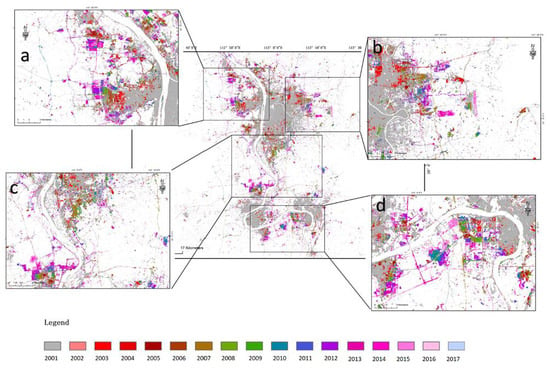Co-Evolution of Emerging Multi-Cities: Rates, Patterns and Driving Policies Revealed by Continuous Change Detection and Classification of Landsat Data
Abstract
1. Introduction
2. Study Area and Datasets
2.1. Study Area
2.2. Data and Pre-Processing
3. Methods
3.1. CCDC Algorithm and Annual LULC maps
3.2. Annual Urban Expansion Rate
3.3. Urban Expansion Types
3.4. Landscape Metrics
4. Result
4.1. Accuracy of the LULC Classification
4.2. Temporal LULC Change from 2001 to 2017
4.3. Spatiotemporal Dynamics of Urban Expansion
4.4. Landscape Changes during Urban Expansion
5. Discussion
5.1. Co-Evolution of Multi-Cities in CZTUA
5.2. Spatiotemporal Dynamics of Urban Expansion and the Possible Drivers
5.3. Urban Expansion under the Guidance of Policy
6. Conclusions
Author Contributions
Funding
Acknowledgments
Conflicts of Interest
Appendix A
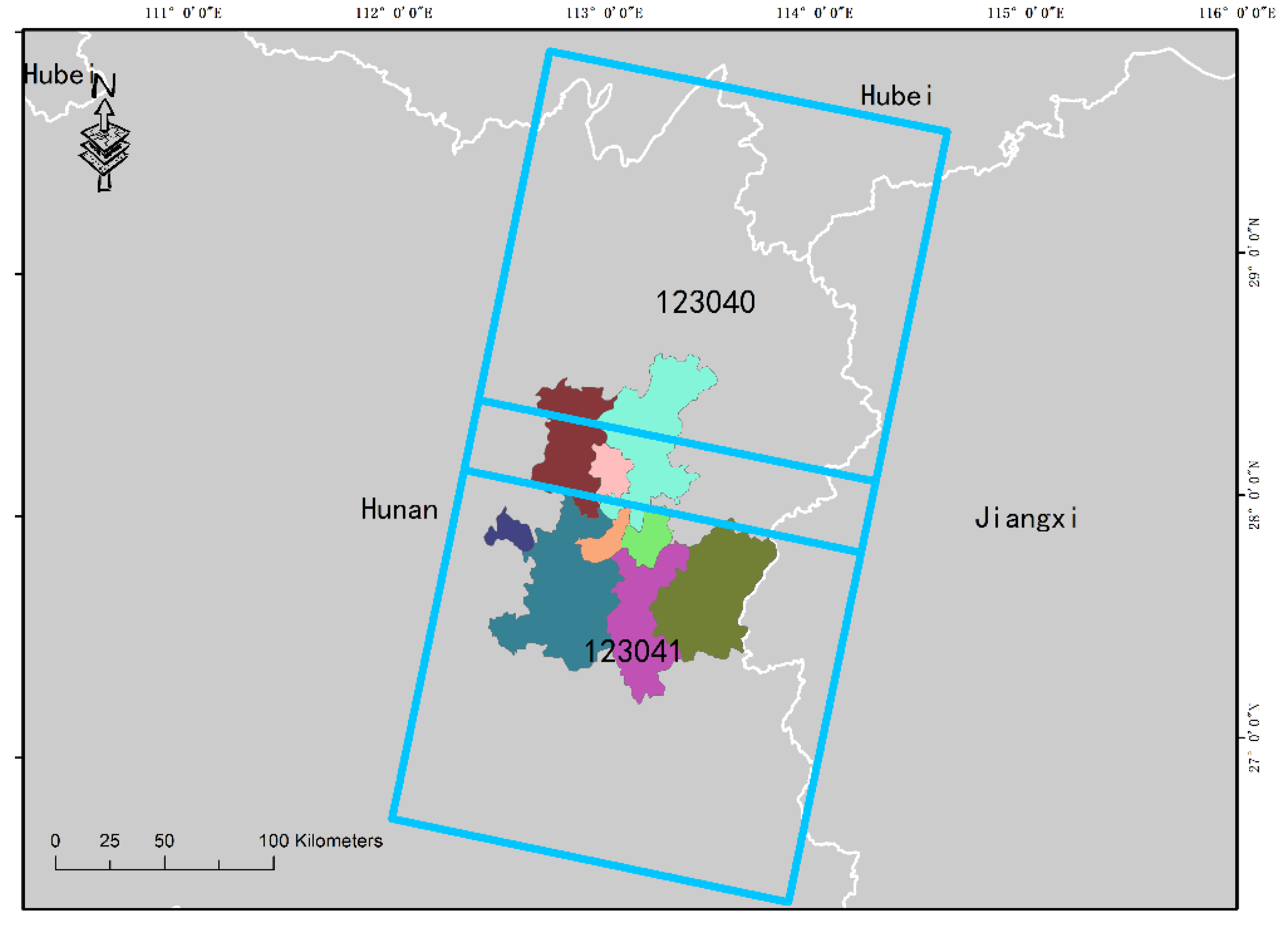
| Year | Cropland | Forest | Grassland | Wetland | Water | Impervious Surface |
|---|---|---|---|---|---|---|
| 2001 | 5297 | 4354 | 12 | 152 | 344 | 808 |
| 2002 | 5298 | 4340 | 13 | 152 | 346 | 820 |
| 2003 | 5286 | 4328 | 13 | 151 | 346 | 844 |
| 2004 | 5281 | 4317 | 13 | 150 | 346 | 863 |
| 2005 | 5279 | 4301 | 13 | 149 | 347 | 881 |
| 2006 | 5273 | 4288 | 14 | 148 | 346 | 902 |
| 2007 | 5259 | 4274 | 14 | 147 | 344 | 933 |
| 2008 | 5252 | 4266 | 14 | 147 | 343 | 949 |
| 2009 | 5237 | 4259 | 15 | 146 | 343 | 971 |
| 2010 | 5229 | 4248 | 15 | 146 | 343 | 989 |
| 2011 | 5218 | 4239 | 15 | 146 | 345 | 1008 |
| 2012 | 5197 | 4225 | 15 | 146 | 345 | 1043 |
| 2013 | 5178 | 4202 | 15 | 146 | 345 | 1084 |
| 2014 | 5174 | 4191 | 15 | 147 | 344 | 1099 |
| 2015 | 5165 | 4174 | 15 | 147 | 344 | 1123 |
| 2016 | 5151 | 4160 | 15 | 147 | 345 | 1144 |
| 2017 | 5128 | 4147 | 15 | 147 | 343 | 1179 |
| Net Change area (km2) | −169 | −206 | 3 | −6 | −1 | 371 |
| Net Change rate (%) | −3.19% | −4.74% | 23.33% | −3.70% | −0.35% | 45.90% |
| Year | 2001 | ||||||
|---|---|---|---|---|---|---|---|
| Cropland | Forest | Grassland | Wetland | Water | Impervious | ||
| 2017 | Cropland | 4920.02 | 166.90 | 0.11 | 4.86 | 4.69 | 11.49 |
| Forest | 69.11 | 4069.46 | 0.03 | 2.06 | 0.93 | 7.05 | |
| Grassland | 1.87 | 1.24 | 10.81 | 0.05 | 0.29 | 1.13 | |
| Wetland | 6.43 | 1.03 | 0.01 | 132.65 | 1.36 | 5.19 | |
| Water | 13.90 | 3.17 | 0.10 | 2.02 | 318.53 | 1.57 | |
| Impervious | 316.57 | 108.37 | 1.41 | 5.54 | 3.51 | 756.24 | |
| Periods | AI | AGR |
|---|---|---|
| 2001–2002 | 11.58 | 1.43 |
| 2002–2003 | 24.61 | 3 |
| 2003–2004 | 18.04 | 2.14 |
| 2004–2005 | 18.63 | 2.16 |
| 2005–2006 | 21.27 | 2.41 |
| 2006–2007 | 30.52 | 3.38 |
| 2007–2008 | 15.84 | 1.7 |
| 2008–2009 | 22.28 | 2.35 |
| 2009–2010 | 18.34 | 1.89 |
| 2010–2011 | 18.6 | 1.88 |
| 2011–2012 | 35.31 | 3.5 |
| 2012–2013 | 41.11 | 3.94 |
| 2013–2014 | 14.6 | 1.35 |
| 2014–2015 | 24.24 | 2.21 |
| 2015–2016 | 21.07 | 1.88 |
| 2016–2017 | 34.95 | 3.05 |
| 2001–2017 | 371 | 2.25 |
| Region | |||||||||
|---|---|---|---|---|---|---|---|---|---|
| Year | Changsha City | Changsha County | Wangcheng District | Liling City | Shaoshan City | Xiangtan City | Xiangtan County | Zhuzhou City | Zhuzhou County |
| 2001 | 211 | 145 | 126 | 63 | 9 | 83 | 57 | 82 | 31 |
| 2002 | 215 | 146 | 128 | 64 | 9 | 84 | 58 | 84 | 32 |
| 2003 | 221 | 152 | 133 | 66 | 9 | 86 | 59 | 86 | 33 |
| 2004 | 224 | 158 | 138 | 68 | 9 | 87 | 59 | 87 | 34 |
| 2005 | 228 | 160 | 142 | 69 | 9 | 88 | 62 | 89 | 35 |
| 2006 | 232 | 164 | 149 | 70 | 9 | 89 | 64 | 90 | 35 |
| 2007 | 236 | 175 | 155 | 71 | 10 | 90 | 67 | 91 | 37 |
| 2008 | 239 | 178 | 158 | 73 | 10 | 91 | 69 | 93 | 39 |
| 2009 | 241 | 183 | 163 | 74 | 10 | 92 | 72 | 94 | 41 |
| 2010 | 244 | 187 | 167 | 76 | 10 | 93 | 74 | 96 | 43 |
| 2011 | 245 | 191 | 171 | 80 | 11 | 93 | 76 | 97 | 44 |
| 2012 | 246 | 197 | 181 | 82 | 11 | 95 | 83 | 100 | 48 |
| 2013 | 247 | 204 | 192 | 86 | 12 | 98 | 94 | 102 | 51 |
| 2014 | 246 | 207 | 197 | 87 | 12 | 98 | 97 | 103 | 52 |
| 2015 | 245 | 212 | 204 | 88 | 12 | 100 | 101 | 104 | 57 |
| 2016 | 245 | 219 | 208 | 90 | 12 | 101 | 104 | 105 | 60 |
| 2017 | 246 | 227 | 217 | 94 | 13 | 103 | 110 | 106 | 64 |
| Net increase area (km2) | 35 | 82 | 91 | 30 | 4 | 20 | 53 | 24 | 33 |
| Net increase rate (%) | 16.38% | 56.80% | 71.91% | 47.54% | 44.56% | 23.64% | 92.79% | 28.95% | 105.10% |
References
- UN DESA (United Nations Department of Economic and Social Affairs). World Urbanization Prospects: The 2018 Revision; United Nations: New York, NY, USA, 2019; Available online: https://www.un.org/development/desa/publications/2018-revision-of-world-urbanization-prospects.html (accessed on 7 July 2020).
- Zhong, Y.; Lin, A.; He, L.; Zhou, Z.; Yuan, M. Spatiotemporal Dynamics and Driving Forces of Urban Land-Use Expansion: A Case Study of the Yangtze River Economic Belt, China. Remote Sens. 2020, 12, 287. [Google Scholar] [CrossRef]
- Mbow, H.O.; Reisinger, A.; Canadell, J.; O’Brien, P. Special Report on Climate Change, Desertification, Land Degradation, Sustainable Land Management, Food Security, and Greenhouse Gas Fluxes in Terrestrial Ecosystems (SR2); IPCC: Ginevra, Switzerland, 2017. [Google Scholar]
- Sun, D.; Zhou, L.; Li, Y.; Liu, H.; Shen, X.; Wang, Z. New-type urbanization in China: Predicted trends and investment demand for 2015–2030. J. Geogr. Sci. 2017, 27, 943–966. [Google Scholar] [CrossRef]
- Stokes, E.C.; Seto, K.C. Characterizing urban infrastructural transitions for the Sustainable Development Goals using multi-temporal land, population, and nighttime light data. Remote Sens. Environ. 2019, 234, 111430. [Google Scholar] [CrossRef]
- Fu, Y.; Li, J.; Weng, Q.; Zheng, Q.; Li, L.; Dai, S.; Guo, B. Characterizing the spatial pattern of annual urban growth by using time series Landsat imagery. Sci. Total Environ. 2019, 666, 274–284. [Google Scholar] [CrossRef]
- Xu, G.; Zhou, Z.; Jiao, L.; Zhao, R. Compact Urban Form and Expansion Pattern Slow Down the Decline in Urban Densities: A Global Perspective. Land Use Policy 2020, 94, 104563. [Google Scholar] [CrossRef]
- Xu, G.; Jiao, L.; Liu, J.; Shi, Z.; Zeng, C.; Liu, Y. Understanding urban expansion combining macro patterns and micro dynamics in three Southeast Asian megacities. Sci. Total Environ. 2019, 660, 375–383. [Google Scholar] [CrossRef]
- Zhou, D.; Zhang, L.; Hao, L.; Sun, G.; Liu, Y.; Zhu, C. Spatiotemporal trends of urban heat island effect along the urban development intensity gradient in China. Sci. Total Environ. 2016, 544, 617–626. [Google Scholar] [CrossRef]
- Zhao, S.; Zhou, D.; Zhu, C.; Sun, Y.; Wu, W.; Liu, S. Spatial and Temporal Dimensions of Urban Expansion in China. Environ. Sci. Technol. 2015, 49, 9600–9609. [Google Scholar] [CrossRef]
- Nuismer, S. Introduction to Coevolutionary Theory, 1st ed.; Macmillan Higher Education: New York, NY, USA, 2017; p. 270. [Google Scholar]
- Madhok, A.; Liu, C. A coevolutionary theory of the multinational firm. J. Int. Manag. 2006, 12, 1–21. [Google Scholar] [CrossRef]
- Fang, C.; Yu, D. Urban agglomeration: An evolving concept of an emerging phenomenon. Landsc. Urban Plan. 2017, 162, 126–136. [Google Scholar] [CrossRef]
- Strange, W.C. Urban Agglomeration. In The New Palgrave Dictionary of Economics; Palgrave Macmillan: London, UK, 2016; pp. 1–5. [Google Scholar] [CrossRef]
- Vance, J.E.; Gottman, J. Megalopolis: The Urbanized Northeastern Seaboard of the United States. Econ. Geogr. 1963, 39, 183. [Google Scholar] [CrossRef]
- Bestor, T.C. Neighborhood Tokyo, 1st ed.; Stanford University Press: Redwood City, CA, USA, 1989. [Google Scholar]
- Zhu, Z.; Wulder, M.A.; Roy, D.P.; Woodcock, C.E.; Hansen, M.C.; Radeloff, V.C.; Healey, S.P.; Schaaf, C.; Hostert, P.; Strobl, P.; et al. Benefits of the free and open Landsat data policy. Remote Sens. Environ. 2019, 224, 382–385. [Google Scholar] [CrossRef]
- Li, F.; Zhao, M.; Zhou, Y.; Zhu, L.; Tian, H. The seasonal and annual impacts of landscape patterns on the urban thermal comfort using Landsat. Ecol. Indic. 2020, 110, 105798. [Google Scholar] [CrossRef]
- Kuang, W.; Zhang, S.; Li, X.; Lu, D. A 30-meter resolution national urban land-cover dataset of China, 2000–2015. Earth Syst. Sci. Data Discuss 2019, 2019, 1–33. [Google Scholar] [CrossRef]
- Wu, W.; Zhao, S.; Zhu, C.; Jiang, J. A comparative study of urban expansion in Beijing, Tianjin and Shijiazhuang over the past three decades. Landsc. Urban Plan. 2015, 134, 93–106. [Google Scholar] [CrossRef]
- Zou, Y.; Peng, H.; Liu, G.; Yang, K.; Xie, Y.; Weng, Q. Monitoring Urban Clusters Expansion in the Middle Reaches of the Yangtze River, China, Using Time-Series Nighttime Light Images. Remote Sens. 2017, 9, 1007. [Google Scholar] [CrossRef]
- Liu, C.; Zhang, Q.; Luo, H.; Qi, S.; Tao, S.; Xu, H.; Yao, Y. An efficient approach to capture continuous impervious surface dynamics using spatial-temporal rules and dense Landsat time series stacks. Remote Sens. Environ. 2019, 229, 114–132. [Google Scholar] [CrossRef]
- Meng, L.; Sun, Y.; Zhao, S. Comparing the spatial and temporal dynamics of urban expansion in Guangzhou and Shenzhen from 1975 to 2015: A case study of pioneer cities in China’s rapid urbanization. Land Use Policy 2020, 97, 104753. [Google Scholar] [CrossRef]
- Dou, Y.; Kuang, W. A comparative analysis of urban impervious surface and green space and their dynamics among 318 different size cities in China in the past 25 years. Sci. Total Environ. 2020, 706, 135828. [Google Scholar] [CrossRef]
- Yue, W.; Qiu, S.; Xu, H.; Xu, L.; Zhang, L. Polycentric urban development and urban thermal environment: A case of Hangzhou, China. Landsc. Urban Plan. 2019, 189, 58–70. [Google Scholar] [CrossRef]
- Unit, Economist Intelligence. Supersized Cities: China’s 13 Megalopolises. The Economist. 2012. Available online: https://www.eiu.com/public/topical_report.aspx?campaignid=Megalopolis2012 (accessed on 17 July 2020).
- Fei, W.; Zhao, S. Urban land expansion in China’s six megacities from 1978 to 2015. Sci. Total Environ. 2019, 664, 60–71. [Google Scholar] [CrossRef] [PubMed]
- Shayesteh, H.; Steadman, P. Coevolution of urban form and built form: A new typomorphological model for Tehran. Environ. Plan. B Plan. Des. 2015, 42, 1124–1147. [Google Scholar] [CrossRef]
- Yin, J.; Yin, Z.; Zhong, H.; Xu, S.; Hu, X.; Wang, J.; Wu, J. Monitoring urban expansion and land use/land cover changes of Shanghai metropolitan area during the transitional economy (1979–2009) in China. Environ. Monit. Assess. 2010, 177, 609–621. [Google Scholar] [CrossRef] [PubMed]
- Hersperger, A.M.; Oliveira, E.; Pagliarin, S.; Palka, G.; Verburg, P.H.; Bolliger, J.; Grădinaru, S.R. Urban land-use change: The role of strategic spatial planning. Glob. Environ. Chang. 2018, 51, 32–42. [Google Scholar] [CrossRef]
- Chakraborty, T.; Lee, X. A simplified urban-extent algorithm to characterize surface urban heat islands on a global scale and examine vegetation control on their spatiotemporal variability. Int. J. Appl. Earth Obs. Geoinf. 2019, 74, 269–280. [Google Scholar] [CrossRef]
- Chai, B.; Seto, K.C. Conceptualizing and characterizing micro-urbanization: A new perspective applied to Africa. Landsc. Urban Plan. 2019, 190, 103595. [Google Scholar] [CrossRef]
- Zhu, Z.; Woodcock, C.E.; Olofsson, P. Continuous monitoring of forest disturbance using all available Landsat imagery. Remote Sens. Environ. 2012, 122, 75–91. [Google Scholar] [CrossRef]
- Yan, J.; Wang, L.; Song, W.; Chen, Y.; Chen, X.; Deng, Z. A time-series classification approach based on change detection for rapid land cover mapping. ISPRS J. Photogramm. Remote Sens. 2019, 158, 249–262. [Google Scholar] [CrossRef]
- Xu, T.; Ma, T.; Zhou, C.; Zhou, Y. Characterizing Spatio-Temporal Dynamics of Urbanization in China Using Time Series of DMSP/OLS Night Light Data. Remote Sens. 2014, 6, 7708–7731. [Google Scholar] [CrossRef]
- Liu, X.; Huang, Y.; Xu, X.; Li, X.; Li, X.; Ciais, P.; Lin, P.; Gong, K.; Ziegler, A.D.; Chen, A.; et al. High-spatiotemporal-resolution mapping of global urban change from 1985 to 2015. Nat. Sustain. 2020, 3, 1–7. [Google Scholar] [CrossRef]
- Zhu, Z.; Woodcock, C.E. Continuous change detection and classification of land cover using all available Landsat data. Remote Sens. Environ. 2014, 144, 152–171. [Google Scholar] [CrossRef]
- Deng, C.; Zhu, Z. Continuous subpixel monitoring of urban impervious surface using Landsat time series. Remote Sens. Environ. 2020, 238, 110929. [Google Scholar] [CrossRef]
- Tang, X.; Bullock, E.L.; Olofsson, P.; Estel, S.; Woodcock, C.E. Near real-time monitoring of tropical forest disturbance: New algorithms and assessment framework. Remote Sens. Environ. 2019, 224, 202–218. [Google Scholar] [CrossRef]
- Zhou, Q.; Liu, S.; Hill, M.J. A Novel Method for Separating Woody and Herbaceous Time Series. Photogramm. Eng. Remote Sens. 2019, 85, 509–520. [Google Scholar] [CrossRef]
- Irwin, E.G.; Bockstael, N.E. The evolution of urban sprawl: Evidence of spatial heterogeneity and increasing land fragmentation. Proc. Natl. Acad. Sci. USA 2007, 104, 20672–20677. [Google Scholar] [CrossRef] [PubMed]
- Tan, Y.; Xu, H.; Zhang, X. Sustainable urbanization in China: A comprehensive literature review. Cities 2016, 55, 82–93. [Google Scholar] [CrossRef]
- Zhang, J.; Yu, L.; Li, X.; Zhang, C.; Shi, T.; Wu, X.; Yang, C.; Gao, W.; Li, Q.; Wu, G. Exploring Annual Urban Expansions in the Guangdong-Hong Kong-Macau Greater Bay Area: Spatiotemporal Features and Driving Factors in 1986–2017. Remote Sens. 2020, 12, 2615. [Google Scholar] [CrossRef]
- Kennedy, R.E.; Yang, Z.; Cohen, W.B. Detecting trends in forest disturbance and recovery using yearly Landsat time series: 1. LandTrendr—Temporal segmentation algorithms. Remote Sens. Environ. 2010, 114, 2897–2910. [Google Scholar] [CrossRef]
- Zhu, L.; Liu, X.; Wu, L.; Tang, Y.; Meng, Y. Long-Term Monitoring of Cropland Change near Dongting Lake, China, Using the LandTrendr Algorithm with Landsat Imagery. Remote Sens. 2019, 11, 1234. [Google Scholar] [CrossRef]
- Huang, C.; Goward, S.N.; Masek, J.G.; Thomas, N.; Zhu, Z.; Vogelmann, J.E. An automated approach for reconstructing recent forest disturbance history using dense Landsat time series stacks. Remote Sens. Environ. 2010, 114, 183–198. [Google Scholar] [CrossRef]
- Tong, X.; Brandt, M.; Yue, Y.; Ciais, P.; Jepsen, M.R.; Penuelas, J.; Wigneron, J.-P.; Xiao, X.; Song, X.-P.; Horion, S. Forest management in southern China generates short term extensive carbon sequestration. Nat. Commun. 2020, 11, 1–10. [Google Scholar] [CrossRef]
- Gómez, C.; White, J.C.; Wulder, M.A. Optical remotely sensed time series data for land cover classification: A review. ISPRS J. Photogramm. Remote Sens. 2016, 116, 55–72. [Google Scholar] [CrossRef]
- Cohen, W.B.; Healey, S.P.; Yang, Z.; Zhu, Z.; Gorelick, N. Diversity of Algorithm and Spectral Band Inputs Improves Landsat Monitoring of Forest Disturbance. Remote Sens. 2020, 12, 1673. [Google Scholar] [CrossRef]
- Tang, X.; Hutyra, L.R.; Arévalo, P.; Baccini, A.; Woodcock, C.E.; Olofsson, P. Spatiotemporal tracking of carbon emissions and uptake using time series analysis of Landsat data: A spatially explicit carbon bookkeeping model. Sci. Total Environ. 2020, 720, 137409. [Google Scholar] [CrossRef] [PubMed]
- Wang, Z.; Lechner, A.M.; Yang, Y.; Baumgartl, T.; Wu, J. Mapping the cumulative impacts of long-term mining disturbance and progressive rehabilitation on ecosystem services. Sci. Total Environ. 2020, 717, 137214. [Google Scholar] [CrossRef]
- Stumpf, F.; Schneider, M.K.; Keller, A.; Mayr, A.; Rentschler, T.; Meuli, R.G.; Schaepman, M.E.; Liebisch, F. Spatial monitoring of grassland management using multi-temporal satellite imagery. Ecol. Indic. 2020, 113, 106201. [Google Scholar] [CrossRef]
- Zhu, Z. Change detection using landsat time series: A review of frequencies, preprocessing, algorithms, and applications. ISPRS J. Photogramm. Remote Sens. 2017, 130, 370–384. [Google Scholar] [CrossRef]
- Zhu, Z.; Gallant, A.L.; Woodcock, C.E.; Pengra, B.W.; Olofsson, P.; Loveland, T.R.; Jin, S.; Dahal, D.; Yang, L.; Auch, R.F. Optimizing selection of training and auxiliary data for operational land cover classification for the LCMAP initiative. ISPRS J. Photogramm. Remote Sens. 2016, 122, 206–221. [Google Scholar] [CrossRef]
- Zhu, Z.; Fu, Y.; Woodcock, C.E.; Olofsson, P.; Vogelmann, J.; Holden, C.; Wang, M.; Dai, S.; Yu, Y. Including land cover change in analysis of greenness trends using all available Landsat 5, 7, and 8 images: A case study from Guangzhou, China (2000–2014). Remote Sens. Environ. 2016, 185, 243–257. [Google Scholar] [CrossRef]
- Fu, P.; Weng, Q. A time series analysis of urbanization induced land use and land cover change and its impact on land surface temperature with Landsat imagery. Remote Sens. Environ. 2016, 175, 205–214. [Google Scholar] [CrossRef]
- Zhu, Z.; Zhou, Y.; Seto, K.C.; Stokes, E.C.; Deng, C.; Pickett, S.T.; Taubenböck, H. Understanding an urbanizing planet: Strategic directions for remote sensing. Remote Sens. Environ. 2019, 228, 164–182. [Google Scholar] [CrossRef]
- Li, Z.; Jiang, W.; Wang, W.; Lei, X.; Deng, Y. Exploring spatial-temporal change and gravity center movement of construction land in the Chang-Zhu-Tan urban agglomeration. J. Geogr. Sci. 2019, 29, 1363–1380. [Google Scholar] [CrossRef]
- Liu, L.; Silva, E.A.; Wu, C.; Wang, H. A machine learning-based method for the large-scale evaluation of the qualities of the urban environment. Comput. Environ. Urban Syst. 2017, 65, 113–125. [Google Scholar] [CrossRef]
- Fan, S.; Kanbur, R.; Zhang, X. China’s regional disparities: Experience and policy. Rev. Dev. Financ. 2011, 1, 47–56. [Google Scholar] [CrossRef]
- Quan, B.; Ren, H.; Pontius, R.G.; Liu, P. Quantifying spatiotemporal patterns concerning land change in Changsha, China. Landsc. Ecol. Eng. 2018, 14, 257–267. [Google Scholar] [CrossRef]
- Berhane, T.M.; Lane, C.R.; Mengistu, S.G.; Christensen, J.R.; Golden, H.E.; Qiu, S.; Zhu, Z.; Wu, Q. Land-Cover Changes to Surface-Water Buffers in the Midwestern USA: 25 Years of Landsat Data Analyses (1993–2017). Remote Sens. 2020, 12, 754. [Google Scholar] [CrossRef]
- Masek, J.; Vermote, E.; Saleous, N.; Wolfe, R.E.; Hall, F.; Huemmrich, K.; Gao, F.; Kutler, J.; Lim, T.-K. A Landsat Surface Reflectance Dataset for North America, 1990–2000. IEEE Geosci. Remote Sens. Lett. 2006, 3, 68–72. [Google Scholar] [CrossRef]
- Claverie, M.; Vermote, E.; Franch, B.; Masek, J.G. Evaluation of the Landsat-5 TM and Landsat-7 ETM+ surface reflectance products. Remote Sens. Environ. 2015, 169, 390–403. [Google Scholar] [CrossRef]
- Roy, D.; Kovalskyy, V.; Zhang, H.; Vermote, E.; Yan, L.; Kumar, S.; Egorov, A. Characterization of Landsat-7 to Landsat-8 reflective wavelength and normalized difference vegetation index continuity. Remote Sens. Environ. 2016, 185, 57–70. [Google Scholar] [CrossRef]
- Schmidt, G.; Jenkerson, C.B.; Masek, J.; Vermote, E.; Gao, F. Landsat ecosystem disturbance adaptive processing system (LEDAPS) algorithm description. Open File Rep. 2013, 27, 2653–2662. [Google Scholar]
- Skakun, S.; Vermote, E.F.; Roger, J.-C.; Justice, C.O.; Masek, J.G. Validation of the LaSRC Cloud Detection Algorithm for Landsat 8 Images. IEEE J. Sel. Top. Appl. Earth Obs. Remote Sens. 2019, 12, 2439–2446. [Google Scholar] [CrossRef]
- Vermote, E.; Tanre, D.; Deuze, J.; Herman, M.; Morcette, J.J. Second Simulation of the Satellite Signal in the Solar Spectrum, 6S: An overview. IEEE Trans. Geosci. Remote Sens. 1997, 35, 675–686. [Google Scholar] [CrossRef]
- Qiu, S.; He, B.; Zhu, Z.; Liao, Z.; Quan, X. Improving Fmask cloud and cloud shadow detection in mountainous area for Landsats 4–8 images. Remote Sens. Environ. 2017, 199, 107–119. [Google Scholar] [CrossRef]
- Qiu, S.; Zhu, Z.; He, B. Fmask 4.0: Improved cloud and cloud shadow detection in Landsats 4–8 and Sentinel-2 imagery. Remote Sens. Environ. 2019, 231, 111205. [Google Scholar] [CrossRef]
- Xu, H.; Wei, Y.; Liu, C.; Li, X.; Fang, H. A Scheme for the Long-Term Monitoring of Impervious—Relevant Land Disturbances Using High Frequency Landsat Archives and the Google Earth Engine. Remote Sens. 2019, 11, 1891. [Google Scholar] [CrossRef]
- Gong, P.; Wang, J.; Yu, L.; Zhao, Y.; Zhao, Y.; Liang, L.; Niu, Z.; Huang, X.; Fu, H.; Liu, S.; et al. Finer resolution observation and monitoring of global land cover: First mapping results with Landsat TM and ETM+ data. Int. J. Remote Sens. 2012, 34, 2607–2654. [Google Scholar] [CrossRef]
- Zhou, Q.; Rover, J.; Brown, J.F.; Worstell, B.B.; Howard, D.; Wu, Z.; Gallant, A.L.; Rundquist, B.; Burke, M. Monitoring Landscape Dynamics in Central U.S. Grasslands with Harmonized Landsat-8 and Sentinel-2 Time Series Data. Remote Sens. 2019, 11, 328. [Google Scholar] [CrossRef]
- Valbuena, R.; Maltamo, M.; Packalén, P. Classification of forest development stages from national low-density lidar datasets: A comparison of machine learning methods. Rev. Teledetección 2016, 45, 15–25. [Google Scholar] [CrossRef][Green Version]
- Awty-Carroll, K.; Bunting, P.; Hardy, A.; Bell, G. Using Continuous Change Detection and Classification of Landsat Data to Investigate Long-Term Mangrove Dynamics in the Sundarbans Region. Remote Sens. 2019, 11, 2833. [Google Scholar] [CrossRef]
- Gong, P.; Liu, H.; Zhang, M.; Li, C.; Wang, J.; Huang, H.; Clinton, N.; Ji, L.; Li, W.; Bai, Y.; et al. Stable classification with limited sample: Transferring a 30-m resolution sample set collected in 2015 to mapping 10-m resolution global land cover in 2017. Sci. Bull. 2019, 64, 370–373. [Google Scholar] [CrossRef]
- Foody, G.M. Explaining the unsuitability of the kappa coefficient in the assessment and comparison of the accuracy of thematic maps obtained by image classification. Remote Sens. Environ. 2020, 239, 111630. [Google Scholar] [CrossRef]
- Forman, R.T.T. Some general principles of landscape and regional ecology. Landsc. Ecol. 1995, 10, 133–142. [Google Scholar] [CrossRef]
- Liu, X.; Li, X.; Chen, Y.; Tan, Z.; Li, S.; Ai, B. A new landscape index for quantifying urban expansion using multi-temporal remotely sensed data. Landsc. Ecol. 2010, 25, 671–682. [Google Scholar] [CrossRef]
- Riitters, K.; O’Neill, R.V.; Hunsaker, C.T.; Wickham, J.D.; Yankee, D.H.; Timmins, S.P.; Jones, K.B.; Jackson, B.L. A factor analysis of landscape pattern and structure metrics. Landsc. Ecol. 1995, 10, 23–39. [Google Scholar] [CrossRef]
- McGarigal, K. FRAGSTATS: Spatial Pattern Analysis Program for Quantifying Landscape Structure; US Department of Agriculture, Forest Service, Pacific Northwest Research Station: Portland, OR, USA, 1995; Volume 351.
- Mellor, A.; Boukir, S.; Haywood, A.; Jones, S. Exploring issues of training data imbalance and mislabelling on random forest performance for large area land cover classification using the ensemble margin. ISPRS J. Photogramm. Remote Sens. 2015, 105, 155–168. [Google Scholar] [CrossRef]
- Jin, H.; Stehman, S.V.; Mountrakis, G. Assessing the impact of training sample selection on accuracy of an urban classification: A case study in Denver, Colorado. Int. J. Remote Sens. 2014, 35, 2067–2081. [Google Scholar] [CrossRef]
- Jürgens, U.; Krzywdzinski, M. Competence development on the shop floor and industrial upgrading: Case studies of auto makers in China. Int. J. Hum. Resour. Manag. 2014, 26, 1204–1225. [Google Scholar] [CrossRef]
- Wan, Y.; Deng, C.; Wu, T.; Jin, R.; Chen, P.; Kou, R. Quantifying the Spatial Integration Patterns of Urban Agglomerations along an Inter-City Gradient. Sustainability 2019, 11, 5000. [Google Scholar] [CrossRef]
- He, Q.; Zeng, C.; Xie, P.; Tan, S.; Wu, J. Comparison of urban growth patterns and changes between three urban agglomerations in China and three metropolises in the USA from 1995 to 2015. Sustain. Cities Soc. 2019, 50, 101649. [Google Scholar] [CrossRef]
- Humphrey, J.; Memedovic, O. The Global Automotive Industry Value Chain: What Prospects for Upgrading by Developing Countries. SSRN Electron. J. 2003, 2, 2–19. [Google Scholar] [CrossRef]
- Chen, J. Rapid urbanization in China: A real challenge to soil protection and food security. Catena 2007, 69, 1–15. [Google Scholar] [CrossRef]
- Dwyer, J.F.; Childs, G.M. Movement of people across the landscape: A blurring of distinctions between areas, interests, and issues affecting natural resource management. Landsc. Urban Plan. 2004, 69, 153–164. [Google Scholar] [CrossRef]
- Kahn, M.E. The environmental impact of suburbanization. J. Policy Anal. Manag. 2000, 19, 569–586. [Google Scholar] [CrossRef]
- Zhang, T. Community features and urban sprawl: The case of the Chicago metropolitan region. Land Use Policy 2001, 18, 221–232. [Google Scholar] [CrossRef]
- Hirschhorn, J.S. Environment, Quality of Life, and Urban Growth in the New Economy. Environ. Qual. Manag. 2001, 10, 1–8. [Google Scholar] [CrossRef]
- Tan, X.; Ouyang, Q.; An, Y.; Mi, S.; Jiang, L.; Zhou, G. Evolution and driving forces of rural functions in urban agglomeration: A case study of the Chang-Zhu-Tan region. J. Geogr. Sci. 2019, 29, 1381–1395. [Google Scholar] [CrossRef]
- Dai, Y.; Feng, L.; Hou, X.; Choi, C.-Y.; Liu, J.; Cai, X.; Shi, L.; Zhang, Y.; Gibson, L. Policy-driven changes in enclosure fisheries of large lakes in the Yangtze Plain: Evidence from satellite imagery. Sci. Total Environ. 2019, 688, 1286–1297. [Google Scholar] [CrossRef]
- Chen, Q.; Song, Y. Methods of dividing the boundary of urban agglomerations: Chang-Zhu-Tan Urban Agglomeration as a case. Sci. Geogr. Sin. 2010, 30, 660–666. [Google Scholar] [CrossRef]
- Yang, B.; Chen, Z.; Zhang, C.; Dong, J.; Peng, X. Distribution patterns and major sources of dioxins in soils of the Changsha-Zhuzhou-Xiangtan urban agglomeration, China. Ecotoxicol. Environ. Saf. 2012, 84, 63–69. [Google Scholar] [CrossRef]

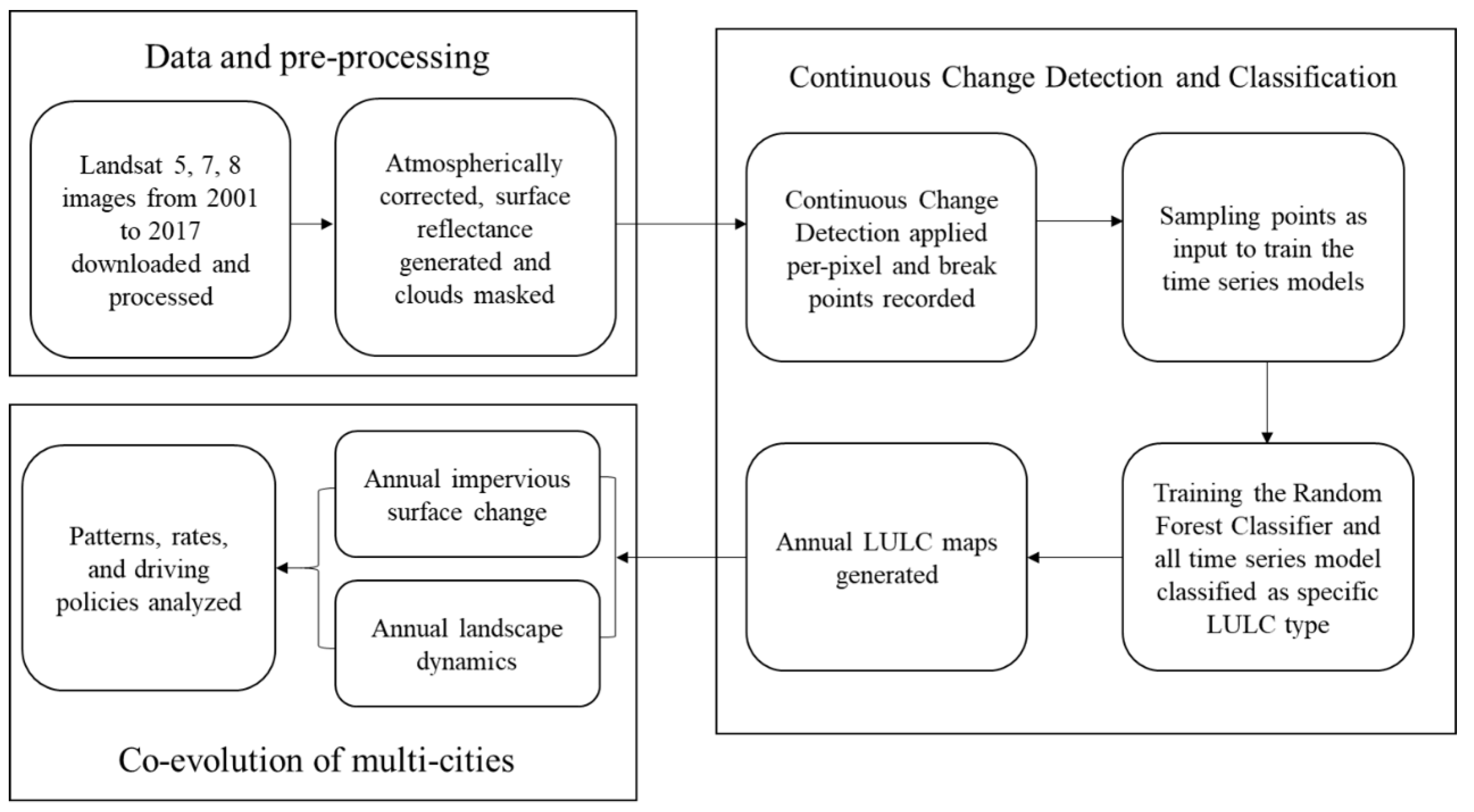
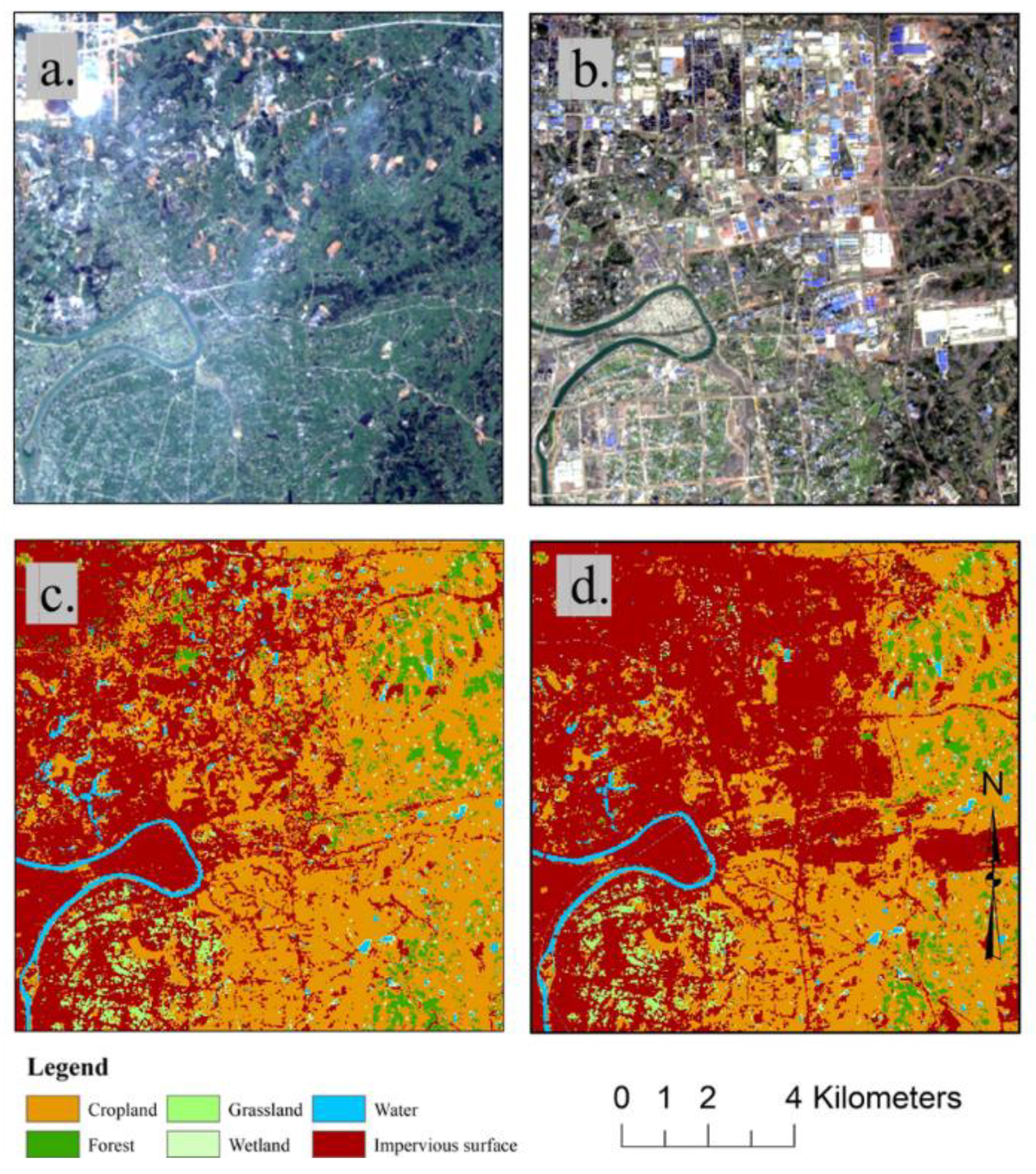
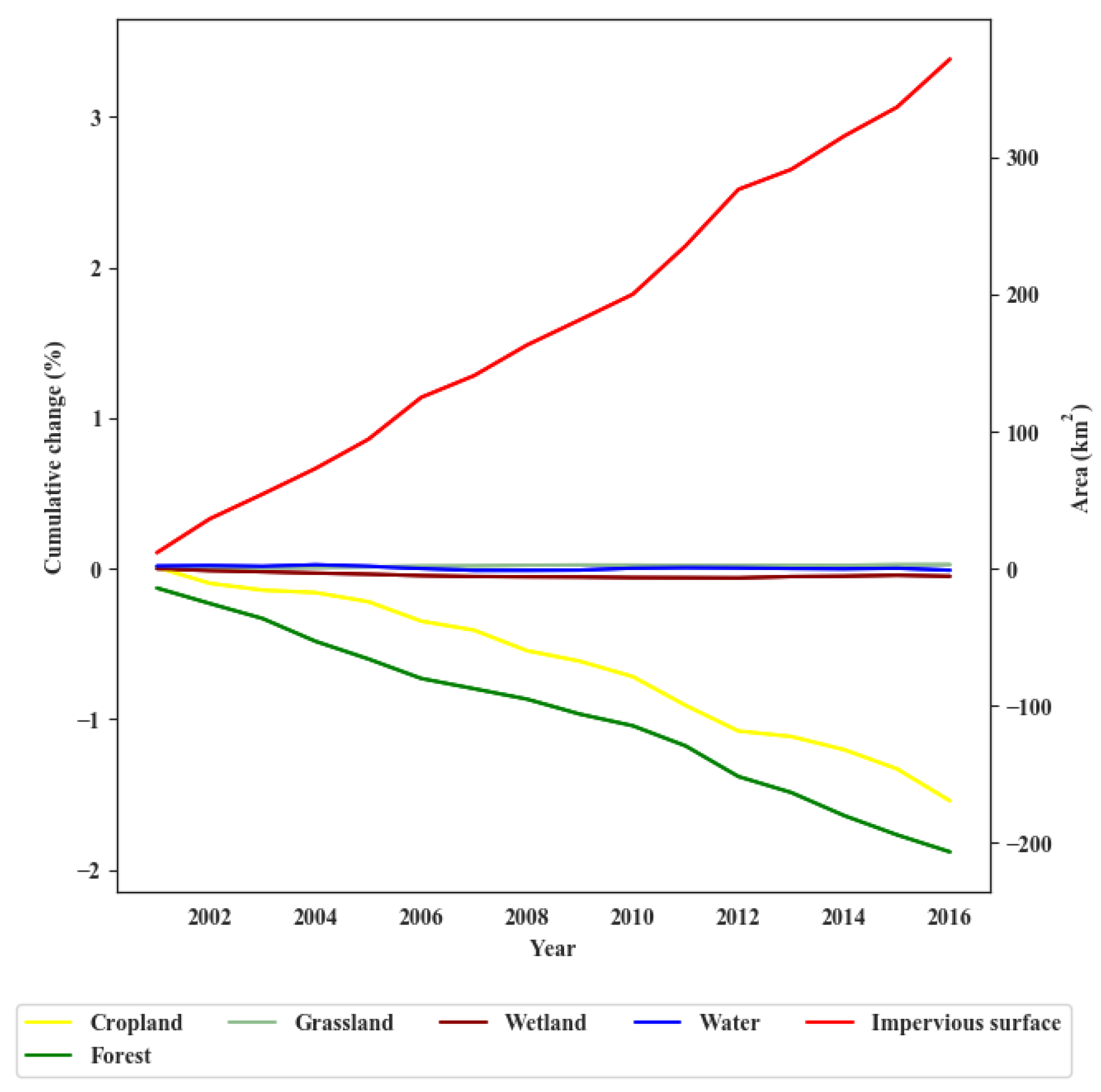
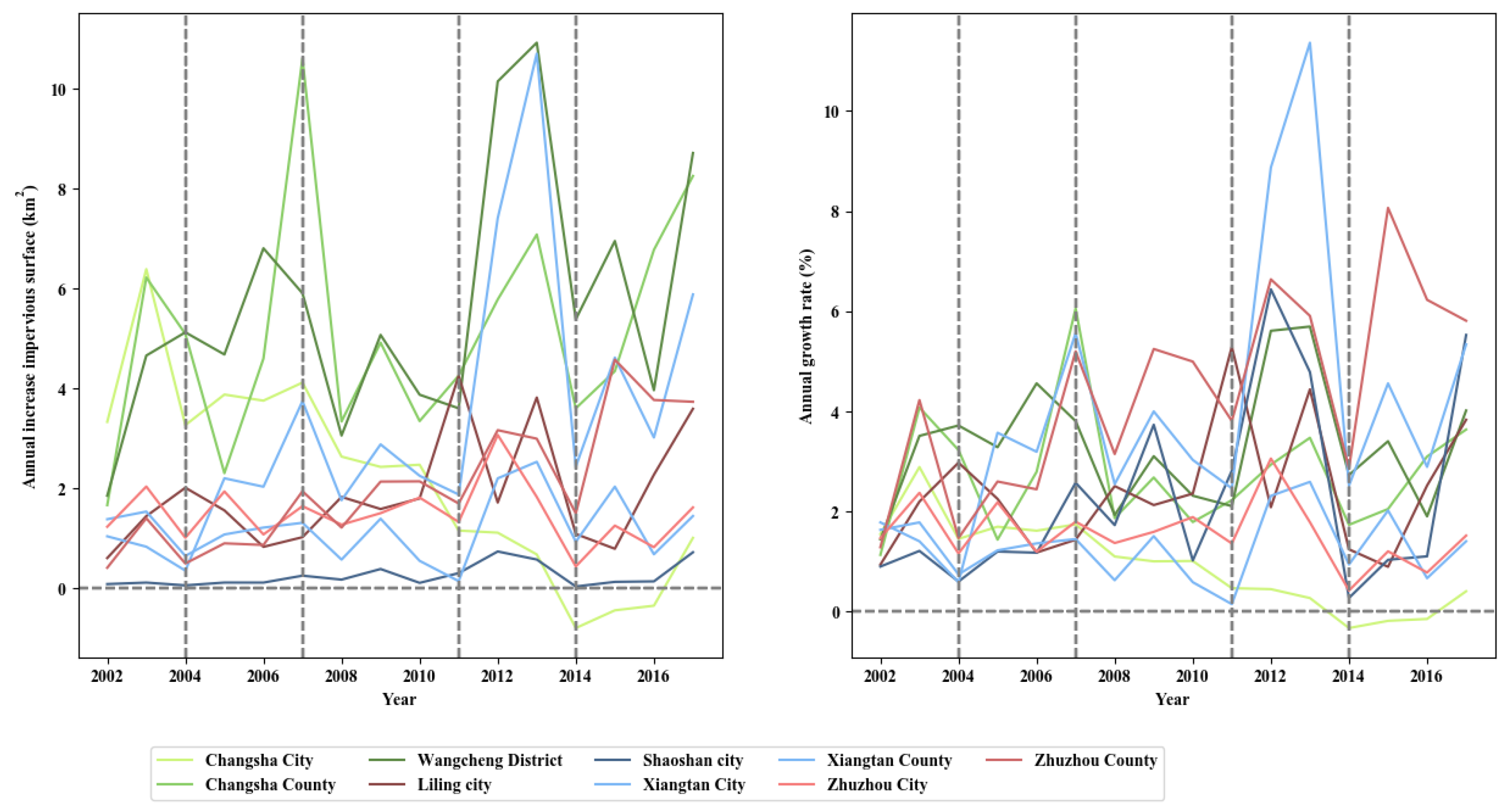
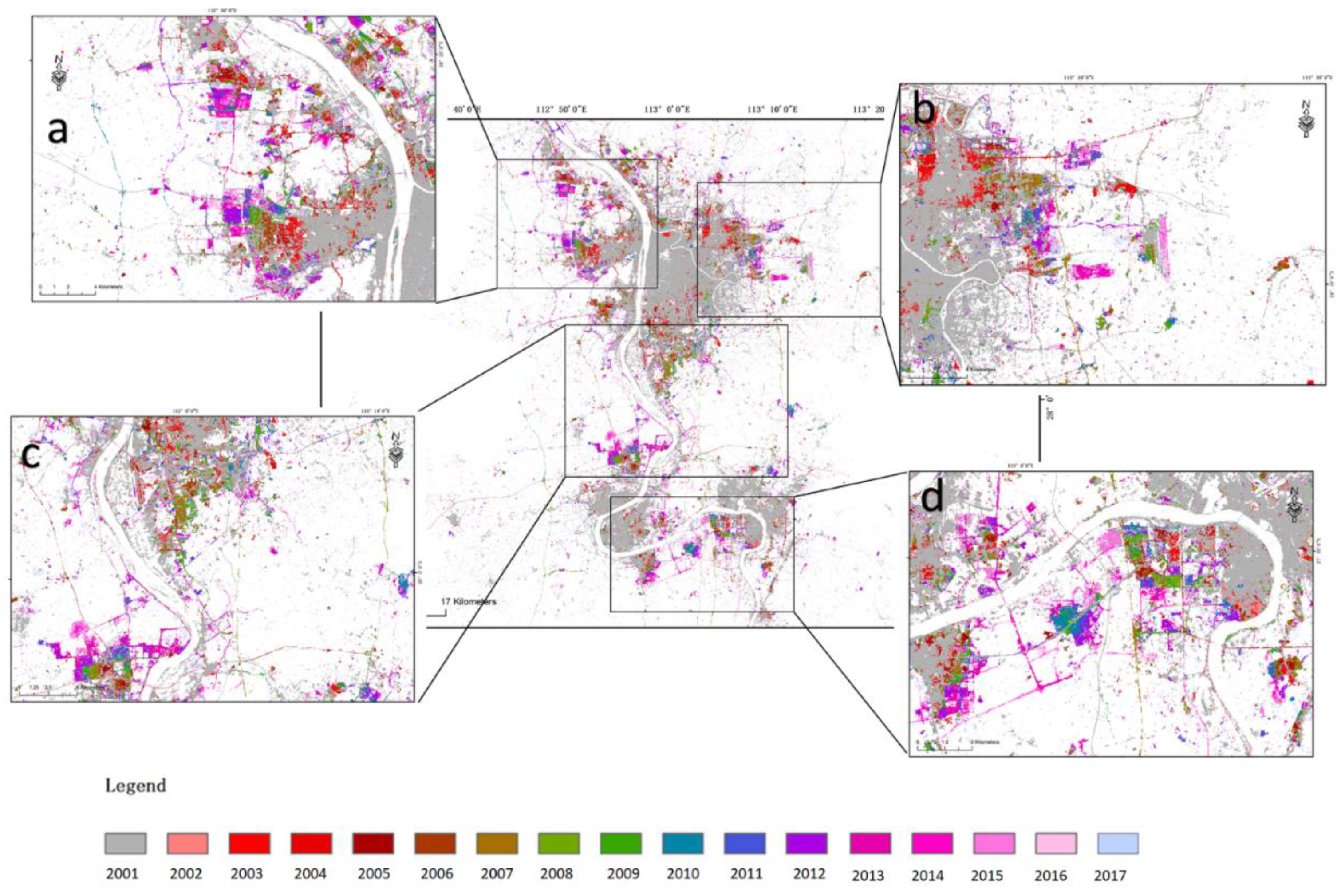


| Landscape Metric | Abbreviation | Description |
|---|---|---|
| Percentage of Landscape | PLAND | The percentage the landscape of the corresponding patch type. |
| Patch Density | PD | The number of patches of per 100 ha. |
| Largest Patch Index | LPI | Proportion of total area occupied by the largest patch of a land cover type. |
| Landscape Shape Index | LSI | A modified perimeter-area ratio of the form that measures the shape complexity of the whole landscape or a specific cover type. |
| Interspersion and Juxtaposition Index | IJI | The overall distribution and juxtaposition of various patch types |
| Patch Cohesion Index | COHESION | Measuring the physical connectedness of the corresponding patch type. |
| Year | LULC | ||||||
|---|---|---|---|---|---|---|---|
| Cropland | Forest | Grassland | Wetland | Water | Impervious surface | ||
| 2001 | Cropland | 1117 | 69 | 4 | 3 | 2 | 24 |
| Forest | 34 | 948 | 0 | 3 | 3 | 2 | |
| Grassland | 1 | 0 | 10 | 0 | 4 | 1 | |
| Wetland | 6 | 2 | 1 | 39 | 0 | 2 | |
| Water | 15 | 1 | 0 | 1 | 132 | 1 | |
| Impervious surface | 20 | 2 | 0 | 2 | 2 | 216 | |
| Producer’s Accuracy | 93.63% | 92.76% | 66.67% | 81.25% | 92.31% | 87.80% | |
| User’s Accuracy | 91.63% | 95.76% | 62.50% | 78.00% | 88.00% | 89.26% | |
| Overall Agreement | 92.31% | ||||||
| 2005 | Cropland | 1127 | 69 | 4 | 3 | 2 | 24 |
| Forest | 54 | 944 | 0 | 5 | 2 | 1 | |
| Grassland | 0 | 0 | 10 | 0 | 0 | 1 | |
| Wetland | 7 | 2 | 1 | 39 | 3 | 0 | |
| Water | 2 | 1 | 0 | 1 | 122 | 1 | |
| Impervious surface | 11 | 10 | 0 | 2 | 2 | 217 | |
| Producer’s Accuracy | 93.84% | 92.01% | 66.67% | 78.00% | 93.13% | 88.93% | |
| User’s Accuracy | 91.70% | 93.84% | 90.91% | 75.00% | 96.06% | 89.67% | |
| Overall Agreement | 92.20% | ||||||
| 2010 | Cropland | 1098 | 98 | 4 | 2 | 3 | 25 |
| Forest | 44 | 930 | 1 | 3 | 4 | 1 | |
| Grassland | 0 | 2 | 11 | 3 | 0 | 1 | |
| Wetland | 6 | 2 | 0 | 38 | 0 | 1 | |
| Water | 3 | 1 | 0 | 2 | 131 | 0 | |
| Impervious surface | 21 | 9 | 1 | 3 | 3 | 216 | |
| Producer’s Accuracy | 93.69% | 89.25% | 64.71% | 74.51% | 92.91% | 88.52% | |
| User’s Accuracy | 89.27% | 94.61% | 64.71% | 80.85% | 95.62% | 85.38% | |
| Overall Agreement | 90.89% | ||||||
| 2015 | Cropland | 1115 | 84 | 3 | 3 | 3 | 27 |
| Forest | 57 | 924 | 0 | 3 | 8 | 2 | |
| Grassland | 2 | 7 | 12 | 0 | 0 | 1 | |
| Wetland | 6 | 2 | 0 | 37 | 0 | 2 | |
| Water | 7 | 1 | 0 | 2 | 117 | 0 | |
| Impervious surface | 16 | 9 | 3 | 3 | 4 | 207 | |
| Producer’s Accuracy | 92.68% | 89.97% | 66.67% | 77.08% | 88.64% | 86.61% | |
| User’s Accuracy | 90.28% | 92.96% | 54.55% | 78.72% | 92.13% | 85.54% | |
| Overall Agreement | 90.44% | ||||||
| 2017 | Cropland | 1107 | 85 | 3 | 3 | 3 | 25 |
| Forest | 43 | 910 | 5 | 3 | 2 | 4 | |
| Grassland | 5 | 0 | 19 | 0 | 3 | 1 | |
| Wetland | 6 | 2 | 0 | 37 | 0 | 1 | |
| Water | 7 | 1 | 0 | 2 | 130 | 2 | |
| Impervious surface | 21 | 12 | 4 | 3 | 4 | 214 | |
| Producer’s Accuracy | 93.10% | 90.10% | 61.29% | 77.08% | 91.55% | 86.64% | |
| User’s Accuracy | 90.29% | 94.11% | 67.86% | 80.43% | 91.55% | 82.95% | |
| Overall Agreement | 90.63% |
© 2020 by the authors. Licensee MDPI, Basel, Switzerland. This article is an open access article distributed under the terms and conditions of the Creative Commons Attribution (CC BY) license (http://creativecommons.org/licenses/by/4.0/).
Share and Cite
Liu, M.; Liu, S.; Ning, Y.; Zhu, Y.; Valbuena, R.; Guo, R.; Li, Y.; Tang, W.; Mo, D.; Rosa, I.M.D.; et al. Co-Evolution of Emerging Multi-Cities: Rates, Patterns and Driving Policies Revealed by Continuous Change Detection and Classification of Landsat Data. Remote Sens. 2020, 12, 2905. https://doi.org/10.3390/rs12182905
Liu M, Liu S, Ning Y, Zhu Y, Valbuena R, Guo R, Li Y, Tang W, Mo D, Rosa IMD, et al. Co-Evolution of Emerging Multi-Cities: Rates, Patterns and Driving Policies Revealed by Continuous Change Detection and Classification of Landsat Data. Remote Sensing. 2020; 12(18):2905. https://doi.org/10.3390/rs12182905
Chicago/Turabian StyleLiu, Maochou, Shuguang Liu, Ying Ning, Yu Zhu, Rubén Valbuena, Rui Guo, Yuanyuan Li, Wenxi Tang, Dengkui Mo, Isabel M.D. Rosa, and et al. 2020. "Co-Evolution of Emerging Multi-Cities: Rates, Patterns and Driving Policies Revealed by Continuous Change Detection and Classification of Landsat Data" Remote Sensing 12, no. 18: 2905. https://doi.org/10.3390/rs12182905
APA StyleLiu, M., Liu, S., Ning, Y., Zhu, Y., Valbuena, R., Guo, R., Li, Y., Tang, W., Mo, D., Rosa, I. M. D., Kutia, M., & Hu, W. (2020). Co-Evolution of Emerging Multi-Cities: Rates, Patterns and Driving Policies Revealed by Continuous Change Detection and Classification of Landsat Data. Remote Sensing, 12(18), 2905. https://doi.org/10.3390/rs12182905





